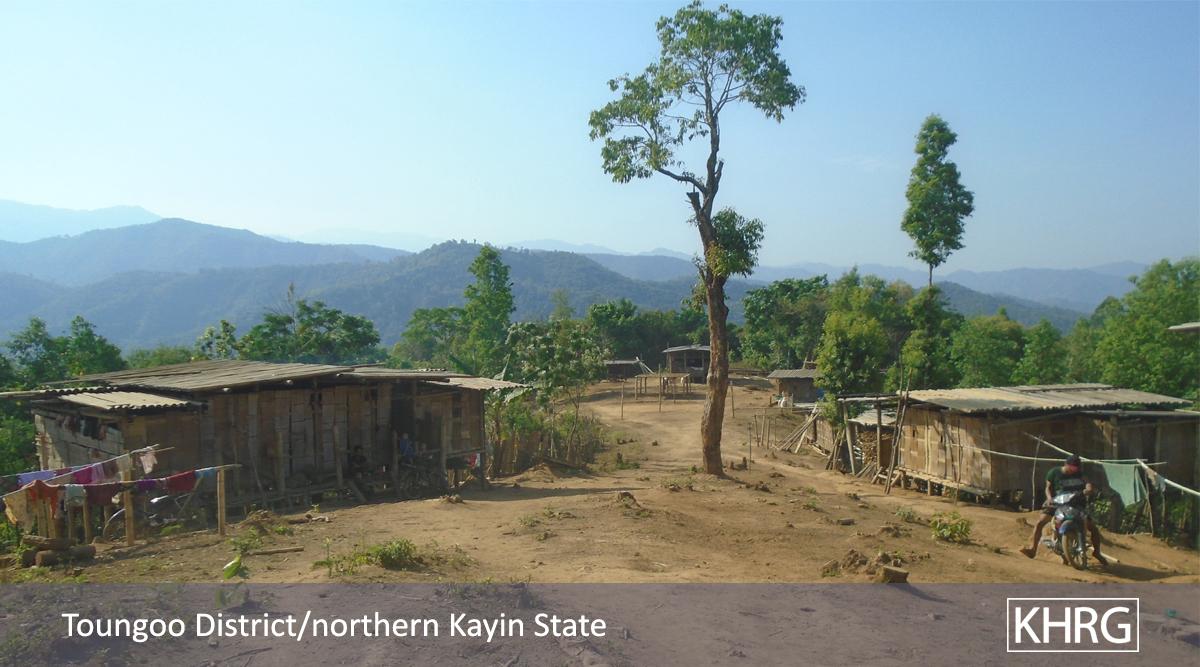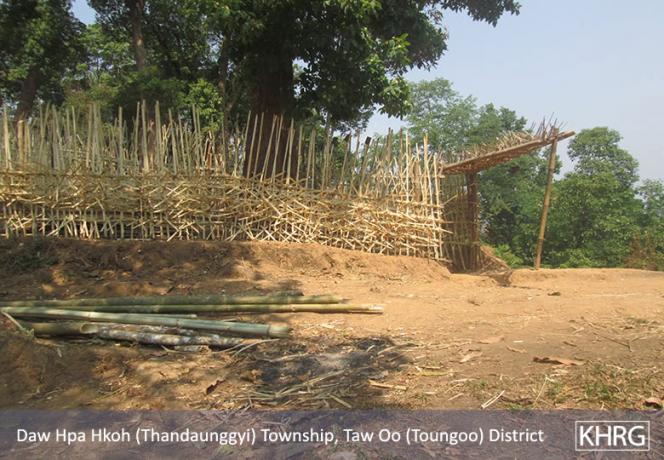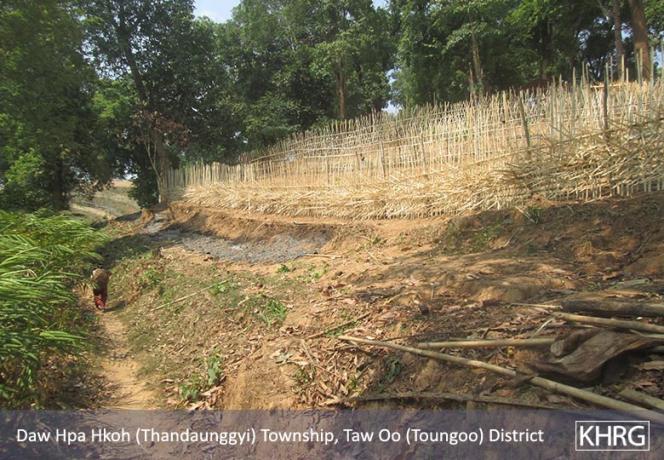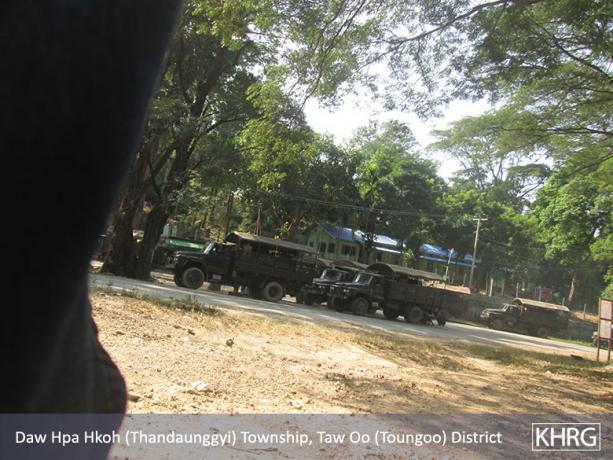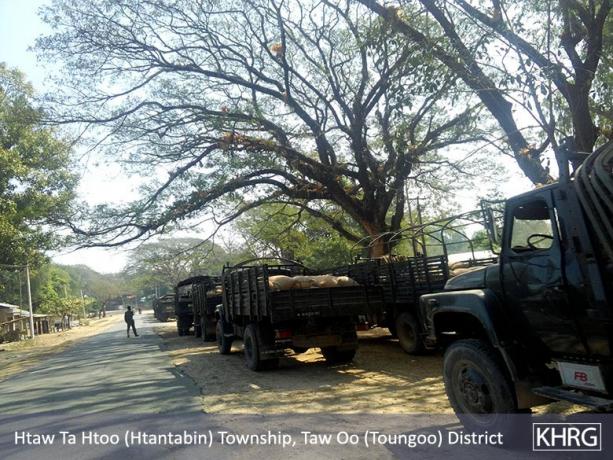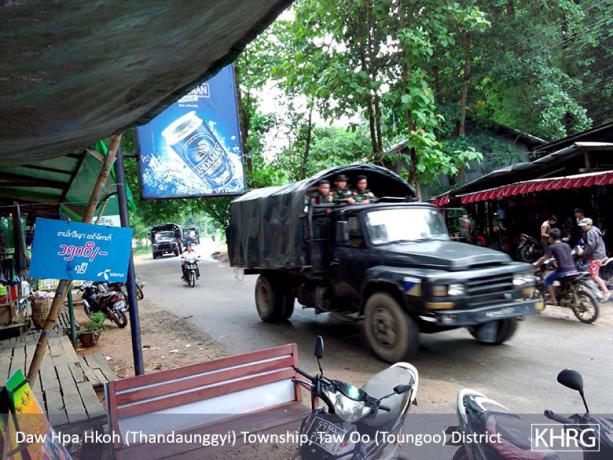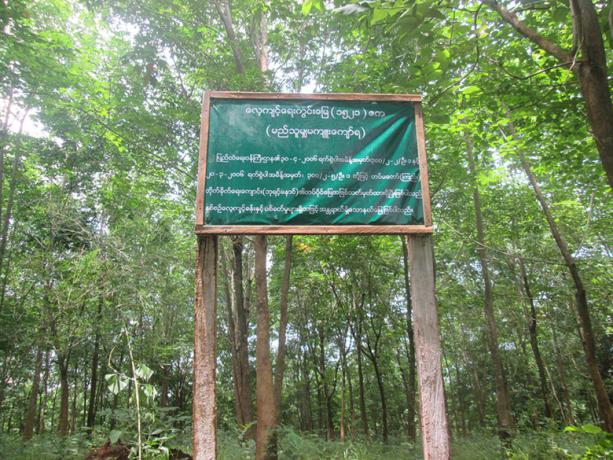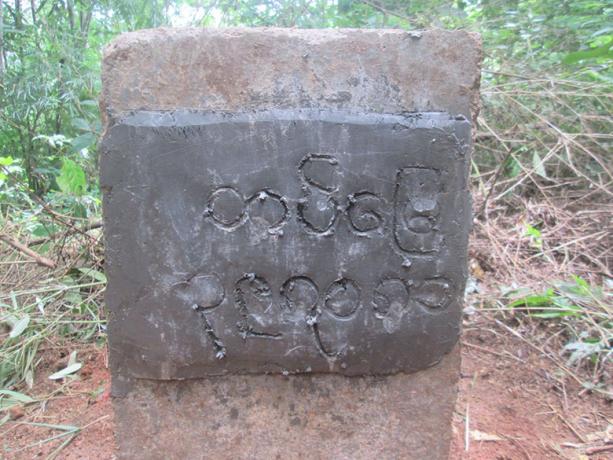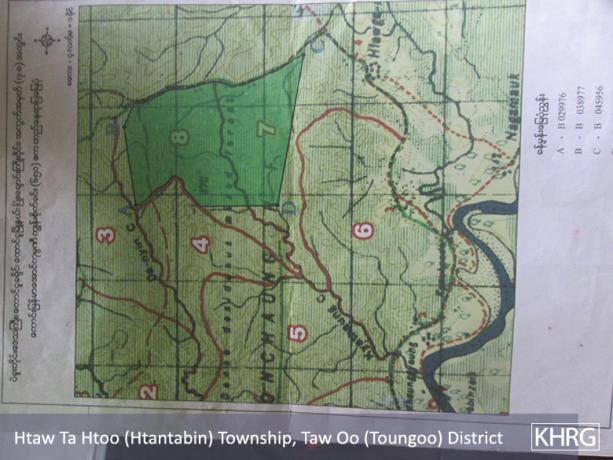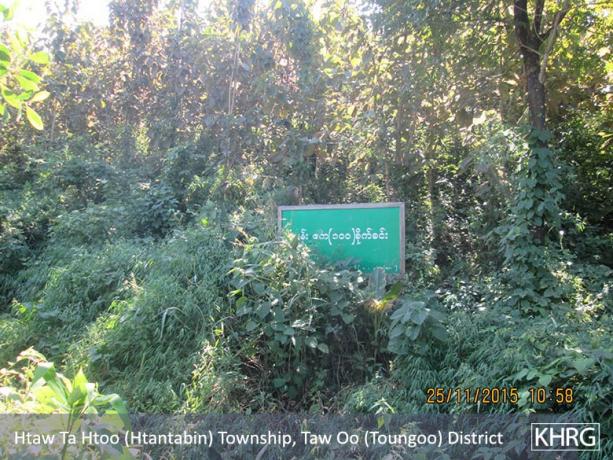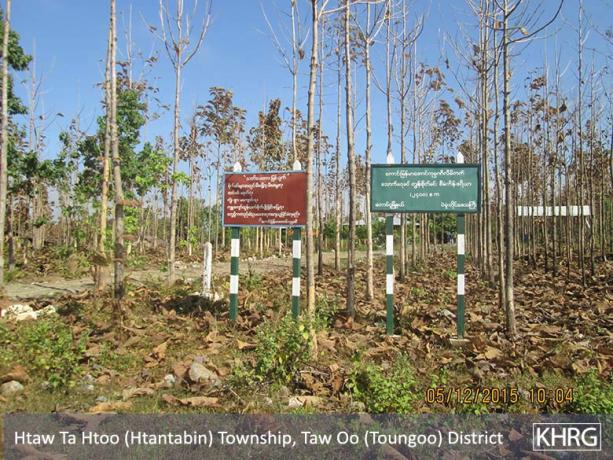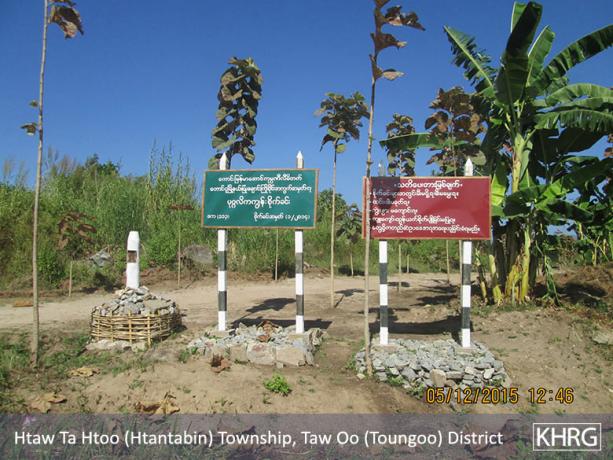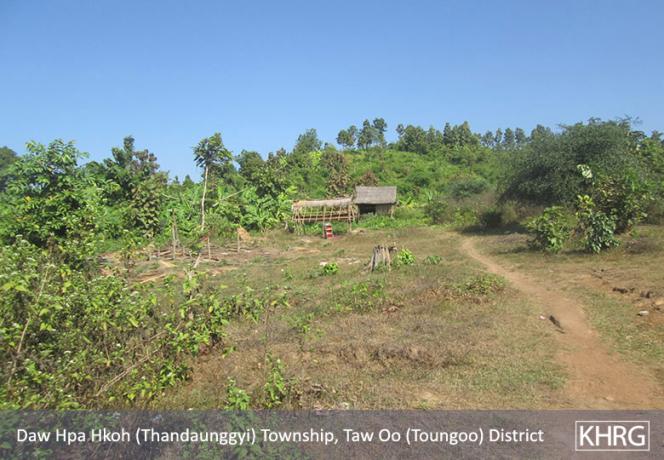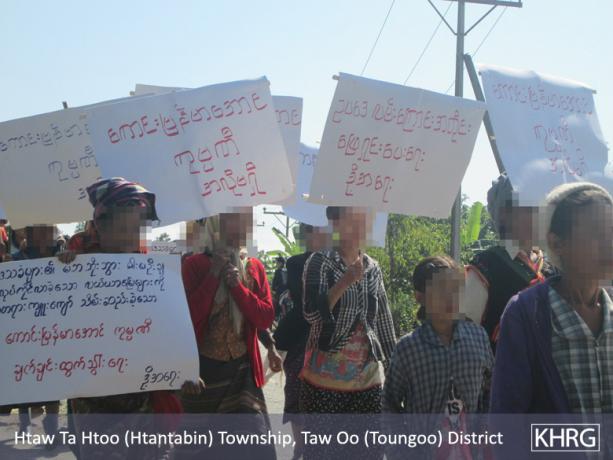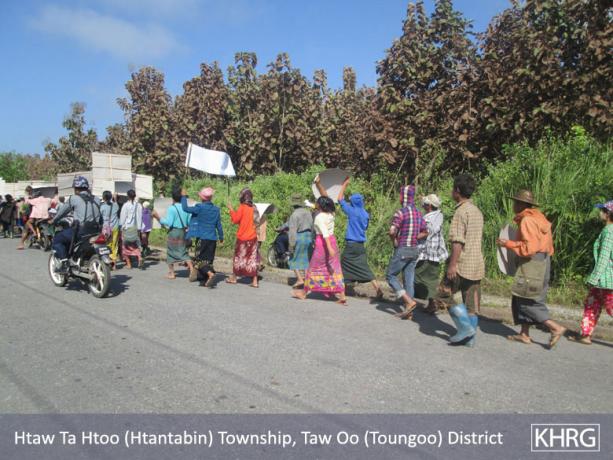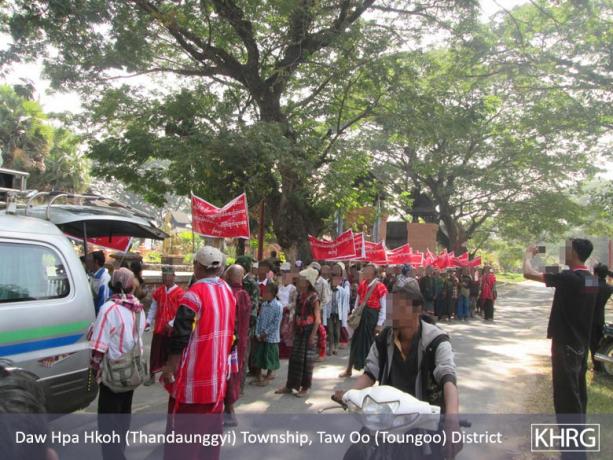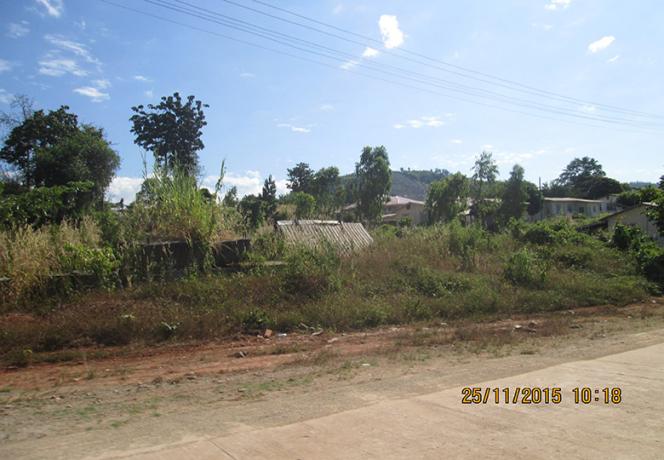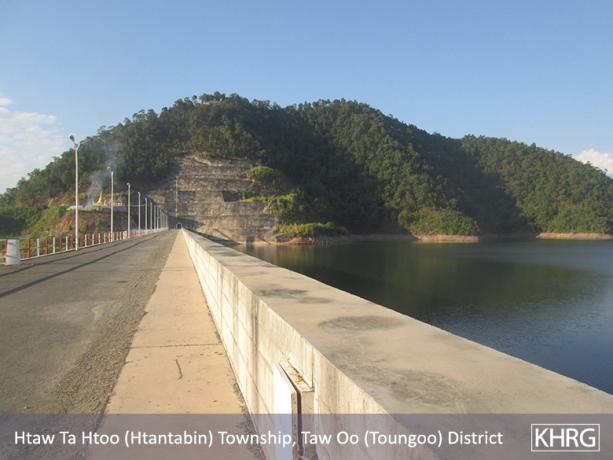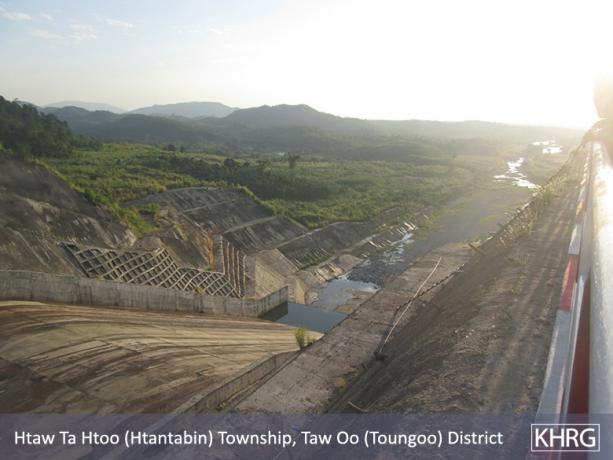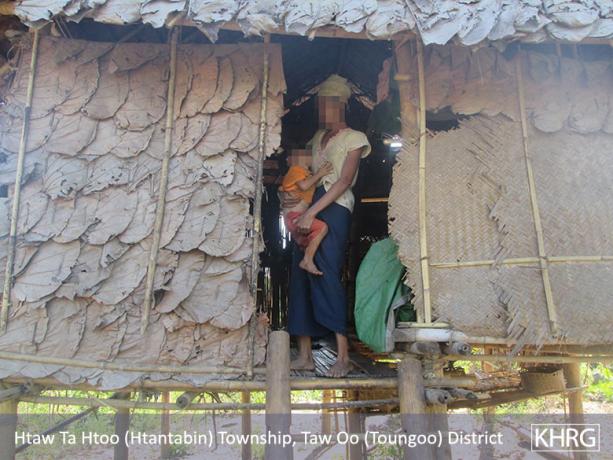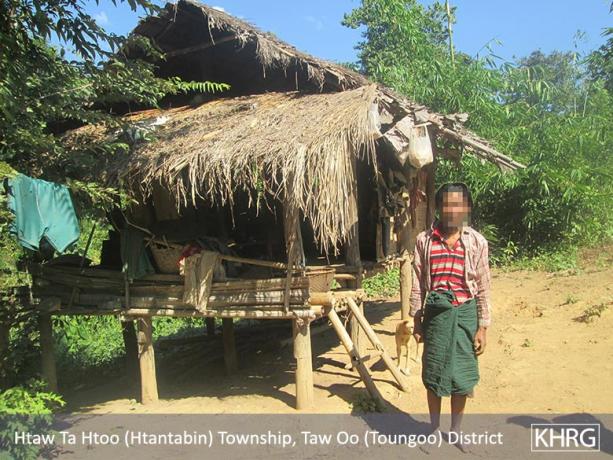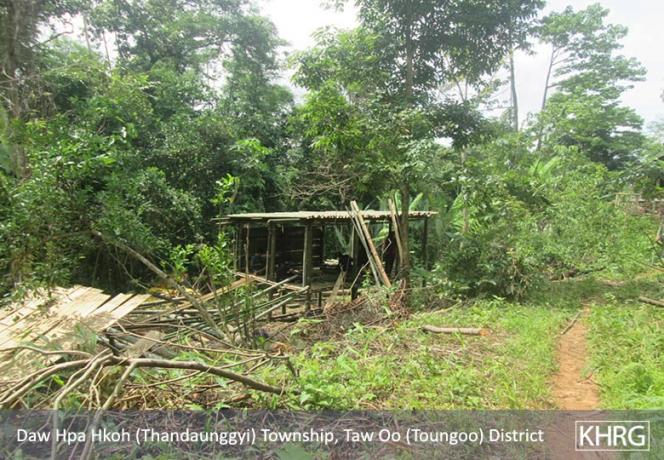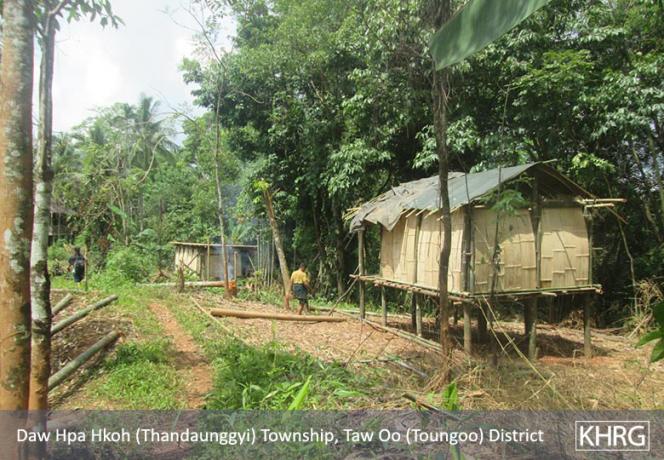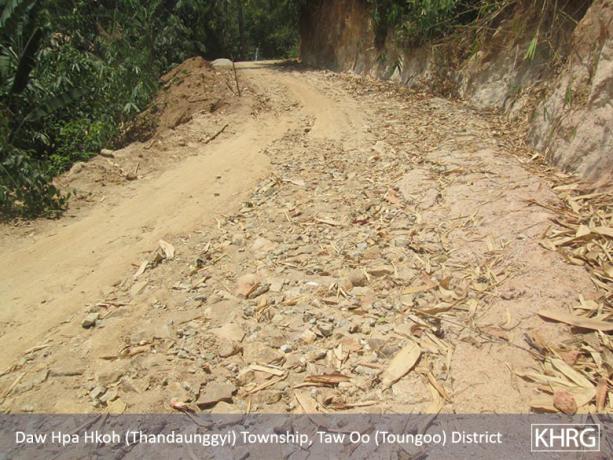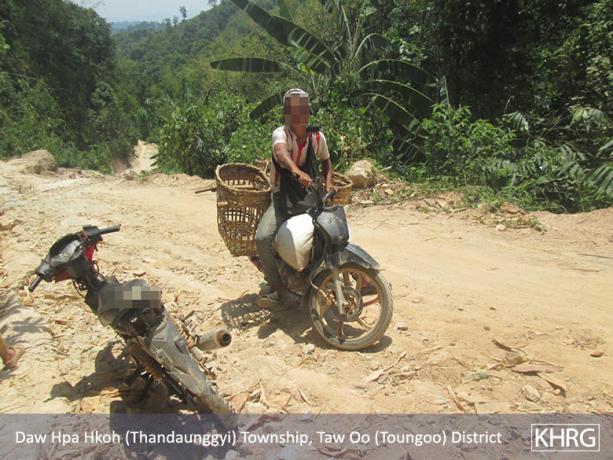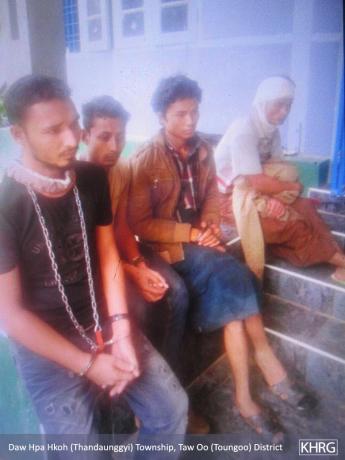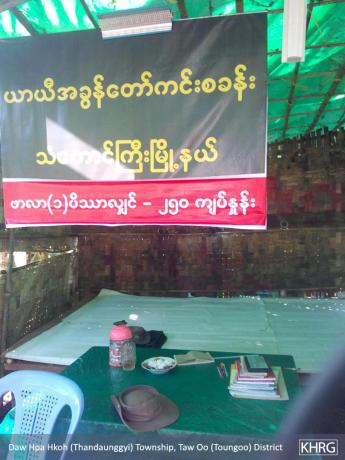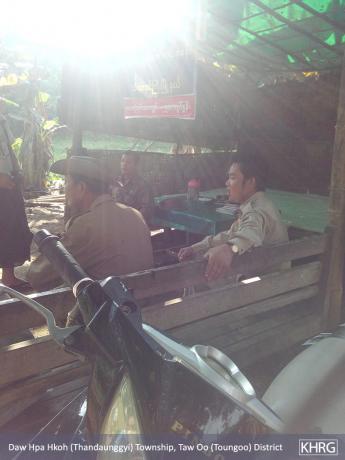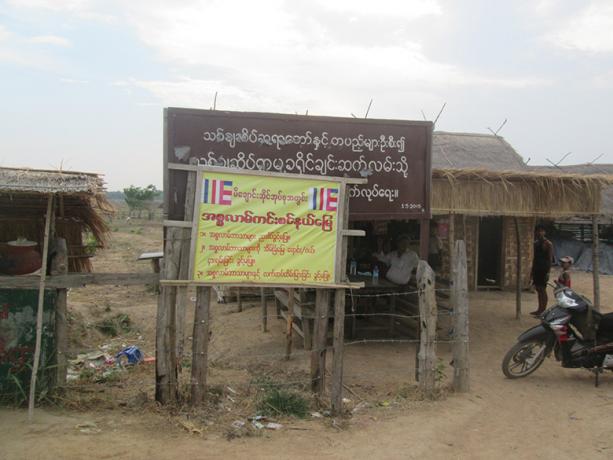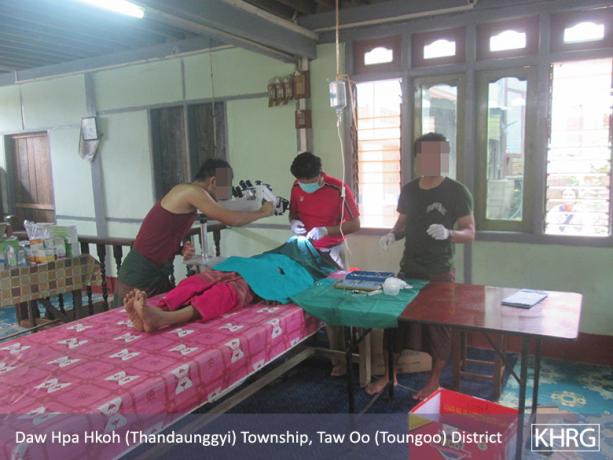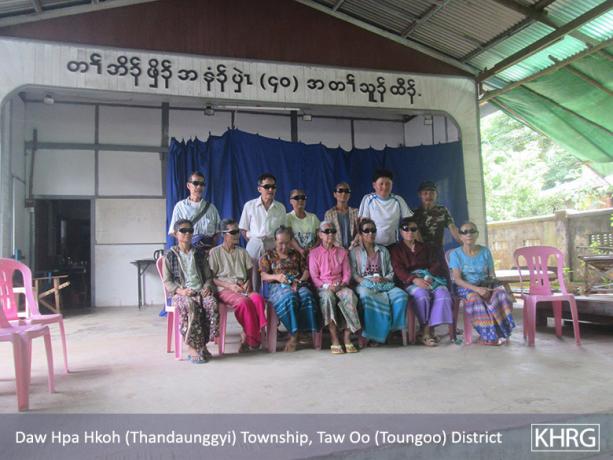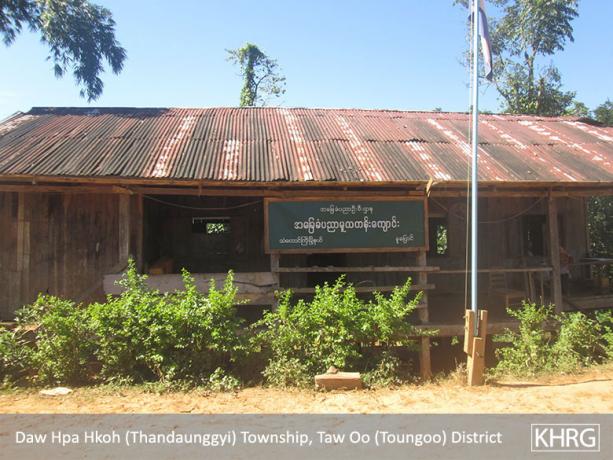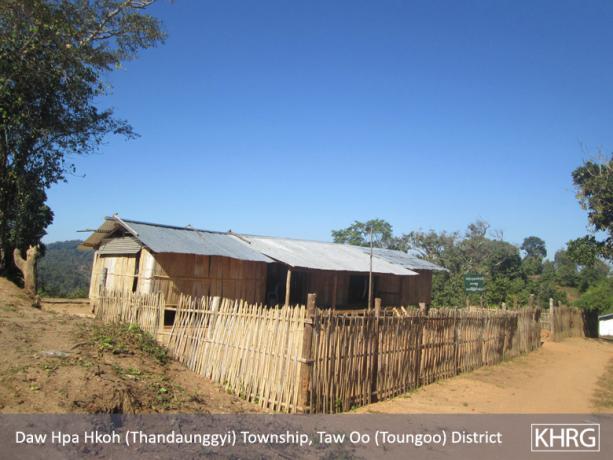This field report includes information submitted by KHRG researchers describing events occurring in Toungoo District between December 2015 and December 2016. It describes different human rights violations and other issues important to the local community including, militarisation, land confiscation, displacement, development projects, discrimination, drugs, taxation, health and education.
- Across all areas of Toungoo District in 2016, ongoing military activities which strengthened army camps and violated the Nationwide Ceasefire Agreement (NCA) Code of Conduct – especially military trainings and troop and ammunition reinforcements by the Tatmadaw – threatened the stability of the current peace process and caused significant safety and livelihood worries for many villagers.
- In 2016, land confiscation remained one of the most important issues causing disputes between villagers and the main perpetrators of land confiscation in Toungoo District: the Tatmadaw, private companies, and the Burma/Myanmar government. Due to concerns about the negative impact of land confiscation on livelihoods, victims of land confiscation in Toungoo District attempted to reclaim their confiscated land by holding protests and using many other different strategies.
- In Toungoo District in 2016, the main cause of forced displacement was the implementation of development projects by powerful economic actors such as Kaung Myanmar Aung Company (KMAC). Although these projects damaged villagers’ land, prior consent was not given and consultation was not provided by companies before their projects were implemented.
- Local villagers have requested the Karen National Union (KNU) to conduct training to local residents about KNU taxation policy in order to increase transparency about tax collection and in order to gain a clearer understanding of how KNU uses taxes.
- Villagers in Toungoo District face significant barriers to accessing medical services due primarily to a lack of medical supplies, financial difficulties, poor infrastructure and an insufficient amount of available healthcare workers.
- Despite the decrease in violence since the 2012 preliminary ceasefire and the NCA, the education situation in Toungoo District has not significantly improved due to poor infrastructure and prohibitive costs, substandard quality of education and teachers, and barriers to implementing culturally appropriate education.
Introduction
This Toungoo District Field Report summarises and analyses in detail villagers’ testimonies and perspectives regarding human rights issues in Htantabin Township and Thandaunggyi Township. Toungoo District is a mixed-control area between the Karen National Union (KNU) and Burma/Myanmar governments. The KNU defines two townships in Toungoo District, Htantabin and Thandaunggyi, whereas the Burma/Myanmar government defines five townships within Toungoo District: Yedashe, Htantabin, Oktwin, Thandaunggyi and Toungoo. For this Field Report, KHRG has analysed information from 37 reports including interviews, situation updates and photo notes documented by KHRG researchers in the period between December 2015 and December 2016.
Militarisation
In 2016, ongoing military activities across all areas of Toungoo District threatened the stability of the current peace process and caused significant safety and livelihood worries for many villagers. Although the Nationwide Ceasefire Agreement (NCA)[1] was signed between the Burma/Myanmar government and Karen ethnic armed groups including the Karen National Union/Karen National Liberation Army (KNU/KNLA), the Democratic Karen Benevolent Army (DKBA)[2] and the KNU/KNLA Peace Council[3] on October 15th 2015, KHRG has regularly highlighted villager concerns about militarisation in reports such as, “Ongoing militarisation in southeast Myanmar,”[4] and “Chapter One: Militarisation” in “Foundation of Fear: 25 years of villagers’ voices from southeast Myanmar.”[5] In 2016, KHRG researchers reported that the Tatmadaw has increased their presence across Toungoo District and strengthened their army camps by sending more rations, troops and military supplies such as ammunition to their army camps, regularly conducting military training and patrolling in civilians areas with full military equipment and uniforms.
Even though there was a reduction of fighting in 2016, Tatmadaw activities remain very high, causing safety and security concerns for villagers. Compared to 2015, the presence of Tatmadaw battalions in Toungoo District has not significantly changed. In 2016, KHRG received detailed information about active Tatmadaw battalions in Htantabin and Thandaunggyi townships, Toungoo District. Active battalions include Infantry Battalion[6] (IB) #73 under the control of Southern Command Headquarters; Light Infantry Battalion[7] (LIB) #543 under Military Operations Command[8] (MOC) #5 operates in Htantabin Township; LIB #124 is based in Thandaunggyi permanent army camp, Thandaunggyi Township; LIB #603 and IB #73 operate in Leik Tho area.[9] LIB #543, LIB #413, LIB #351, LIB #414, LIB #264, LIB #590, Infantry Battalion (IB) #84, IB #48, and IB #39 are under the control of Tactical Operation Command[10] (TOC) #1 and MOC #6.[11] Other active battalions include LIB #288, LIB #581, LIB #582, LIB #584, LIB #592, LIB #593, LIB #594, LIB #595, MOC #20, TOC #2 and TOC #3.[12] MOC #20 is led by Major General Aung Myo Thant and rotates their troops monthly and Operation Command rotated their troops every quarter. Some battalions transport rations every three to four months and some transport rations once a week.[13] For example, a Situation Update written by a KHRG researcher reported that between December 29th 2015 and January 19th 2016, the Tatmadaw transported rations with 70 trucks and 100 horses to Kler La area and to Buh Hsa Hkee, Kler La, Klaw Mee Der Than Daung Gyi and Kaw Thay Der army camps.[14] Furthermore, KHRG researchers in Toungoo District reported that on July 25th 2015, commander-in-chief of the armed forces, Senior General Min Aung Hlaing went to visit Bu Yin Naung Army Camp, Thandaunggyi Township. Villagers interpreted the purpose of his visit as an effort to organise and reinforce Tatmadaw troops on the frontline in the east of Thandaunggyi Township.[15]
In addition to sending rations, the Tatmadaw also set up security along the roads and stayed in villagers’ houses and schools; this increased villagers’ doubts about the effectiveness of the current peace process. At Bu Yin Naung Military training camp, Thandaunggyi Township, the Tatmadaw also conducted military training every four months. They fired artillery, mortars and participated in other training activities that resulted in the damage and destruction of many villagers’ plantation fields. These trainings also caused safety concerns for villagers because although the Tatmadaw attempted to give prior notice and inform local civilians about their trainings, the information did not arrive on time due to poor communication services in the area.[16] Furthermore, villagers who own or work on land near the training compound face difficulties securing their livelihoods and physical security.
Due to the heavy presence of Tatmadaw battalions in Toungoo District, villagers worry about their security and avoid being alone as a precaution. For example, as battalions have built their camps near villages, many female villagers worry about staying at home when their husbands are away. According to Naw[17] A---, in L--- village:
“If our husbands are away we are afraid [to sleep at home]. I always tell my husband ‘When you are away from home I am afraid of the Tatmadaw if they come to our home so what should I do?’ This is our concern.”[18]
Women in L--- village also feel insure about traveling to collect firewood because the Tatmadaw also collect firewood from their land compound. In order to reduce the risk of violence, female villagers tried to pressure the village head by asking,
“Why are you not telling them to stop [collecting] the firewood? As we are women we do not feel safe traveling alone [to collect firewood] because of all the Tatmadaw [soldiers].”[19]
According to analysis by KHRG community members, the Tatmadaw have been violating the NCA Code of Conduct by regularly reinforcing their troops in front line army camps, and strengthening army camps by supplying ammunition and weaponry.[20] Due to these violations of the NCA Code of Conduct, villagers report concerns about potential outbreaks of armed conflict. In Thandaunggyi Town on December 20th 2015, 70 Tatmadaw soldiers with four vehicle trucks arrived at section 3 of Thandaunggyi Town without giving prior notice to civilians. As the Tatmadaw soldiers had heard that the KNLA would come and open fire at them, they brought large amounts of artillery to the town in anticipation of a fight against the KNLA. Fortunately, they did not see any KNLA soldiers when they were there and no violence broke out.[21] Nevertheless, incidents such as these cause villagers feel insecure and lack trust in the stability of the current peace process.
Villagers’ insecurity also increased after an incident in which the Tatmadaw prevented KNLA soldiers from raising the Karen national flag. On December 23rd 2015, Tatmadaw Cantonment Area Commander U[22] Soe Tin Naing from Bu Yin Naung Camp Town ordered Battalion Deputy Commander Ye Min Naing from IB #39 and Company Commander Thaw Kin Aung to take down the Karen national flag raised by KNLA soldiers based near L--- village, Thandaunggyi Township. The two Tatmadaw commanders then announced to the KNLA:
“Cantonment Area Commander U Soe Tin Naing in Bu Yin Naung camp Town dislikes the Karen flag that you raised; you have to put it down. Otherwise, it will turn into a conflict.” [23]
Although two Karen soldiers initially took the Karen flag down, they raised the flag again the following day and so the Tatmadaw again returned to the KNLA army camp and demanded that the flag be taken down. Local villagers worry that the lack of mutual respect between the Tatmadaw and the KNLA may lead to an outbreak in armed conflict.
In Toungoo District, villager concerns about militarisation are heightened by the impunity and unaccountability for Tatmadaw actions. For example, the Tatmadaw from Southern Command Headquarters killed two villagers in a car accident while transporting rations on May 5th 2016. However, the Tatmadaw did not provide any remedy for the victims’ families and instead took the driver, Ko Ye, to a military court. The local community could not confirm whether he was punished or not as the military’s justice system is not transparent.
In order to ensure that the peace process is maintained and increase the level of trust of local civilians, all armed actors, especially the Tatmadaw, should strictly follow the NCA Code of Conduct by ceasing troop and ammunition reinforcements, improving communication and transparency with local civilians, and reducing military patrols in civilian areas. Mutual respect for all ethnic cultures should also be prioritised by all armed actors.
Land confiscation
The majority of KHRG reports received in 2016 from Toungoo District highlight land disputes as one of the most important issues and community concerns. Conflicting priorities about the appropriate use of land has been a source of tension and conflict across all districts in Karen state and many disputes between villagers and powerful actors remain unaddressed. Specifically in Toungoo District, the most common perpetrators of land confiscation were the Tatmadaw, private companies and the Burma/Myanmar government. Confiscated land is most often used by private companies for large scale development projects and other profitable enterprises, and is used by the Tatmadaw for military purposes such as the construction of military buildings, strengthening army camps and establishing military training grounds.[24]
Since 2015, victims of land confiscation in Toungoo District have repeatedly attempted to reclaim confiscated land by using many different types of strategies to support their effort, including protests, complaint letters, and the rejection of compensation offers. In response to these efforts, perpetrators of land confiscation have brought villagers to court and attempted to avoid consulting or negotiating with villagers.
Bu Yin Naung land confiscation
The Tatmadaw in Thandaunggyi Township, Toungoo District currently maintain both an army camp and a military training centre (Military Training Centre No. #2). Both the camp and the training centre were constructed on land confiscated from local residents and have been operational for many years. Since 2006, the Tatmadaw has continuously confiscated villagers’ land in Shauk Pin Chaw, Ywa Gyi, Ngway Taung Gyi and Kwun Pin village tracts,[25]Thandaunggyi Township, Toungoo District. According to local residents, signs posted by the Tatmadaw in 2016 asserted that 1,521 acres of land had been part of Bu Yin Naung army camp since 2006. In fact, by 2015 up to 5,000 acres of land was confiscated for the Tatmadaw to maintain a military centre and training school, as well as additional land for the Tatmadaw’s decades-old military camp in the area. Although from 2007 to 2009 the Tatmadaw temporarily stopped using the land as a military centre, between 2014 and 2016, they resumed using the land and have set up new posts and fences since 2015.
Other Tatmadaw and Burma/Myanmar government land confiscation and village agency
As detailed in the previous section, the Tatmadaw based inThandaunggyi Town, Htantabin Township have confiscated 5,000 acres of villagers’ ancestral land to establish the Bu Yin Naung military training centre, school buildings and other military purposes.[26] Furthermore, 1,500 acres of land was confiscated by Light Infantry Battalion (LIB) #104 in Thandaunggyi area and both Light Infantry Division (LID) #106 and Infantry Battalion (IB) #73 confiscated 3,000 acres of land in Leik Tho area.[27]Land owners were not informed or provided with an opportunity to give consent to the Tatmadaw land confiscation. However, this does not imply that villagers were silent or inactive in response to this threat to their livelihoods. Many villagers attempted to gain more detailed information about the land confiscation and some villagers even directly confronted Tatmadaw soldiers and demanded to know if the land confiscation was permitted by township administrators. Says Saw[28] B---,
“In 2016 the Tatmadaw troops confiscated the land and told the villagers that we lived on trespassed land. This made the villagers very stressed and heartbroken. Currently, villagers are attempting to meet with many groups [and organisations] to discuss whether and how we would be able to receive compensation and escape this stressful situation. We were encouraged during these meetings and very happy to meet with many groups.”
In response to these arguments by villagers, the Tatmadaw justified the land confiscation by claiming that the land grants villagers possess were illegal and that the villagers therefore did not have a right to work on or own the land. When villagers then attempted to measure their land in order to acquire land form #7[29] the land records department of the Burma/Myanmar government refused and claimed that since the land was located in trespassed areas it would not be possible for villagers to acquire land form #7.
After facing these barriers, villagers attempted to seek support and meet with many groups working on land issues in order to try and acquire legal documentation, regain the land, or at least receive compensation. Villagers also met with the government development office workers and asked them to intervene. Says Saw B---,
“We went to meet with Moe Ma Kha to assess the situation for the villagers and phoned people who work on the country development. After they [Burma/Myanmar government development office] came here we told them about the incident and we asked them to deal with this issue for us. Ka Ma Ya [LIB officer] and Hka Ya Ka [village tract administrator] did not act in the right way.”
When compared to village agency tactics used before the 2012 preliminary ceasefire agreement in which the priority was often to avoid the negative impact of Tatmadaw abuses, villagers in Toungoo District in 2016 were more likely to use confrontational agency tactics against the Tatmadaw. This change in village agency tactics can be understood as a response to attempts by the Tatmadaw to decrease transparency and limit the ability of villagers to respond or negotiate by only communicating with government officials such as the village tract administrator and the home affairs ministry.[30]
In a separate case of land confiscation by LIB #603 under the control of the Southern Command Headquarters, 27 villagers’ lands were confiscated; after this land confiscation, villagers were called to go to the General Administration Office in Leik Tho Town and told that they would receive 600,000 kyat[31] (US $453.51) per acre of land as compensation from LIB #603. Only nine of the 27 villagers accepted this offer; the other 18 villagers refused to accept compensation because they want to regain their land from the Tatmadaw in order to meet their basic needs and survive. Many land victims do not accept compensation as land is essential for them to work and secure their livelihoods. A KHRG community member concludes,
“Therefore, nine people [farmers] went to take compensation at the community hall in Leik Tho Town. The rest of the people [farmers] did not want to accept 600,000 kyat [US $453.51]. They [farmers] will instead keep cooperating with the house of representatives, the district of representatives, organisations who work on land issues and other organisations in order to regain their lost lands.” [32]
In addition to the Tatmadaw, KHRG also reported on a case of land confiscation in Sa Pin Gyi village tract, Thandaunggyi Township in which the local Burma/Myanmar government forest department measured and confiscated more than 300,000 acres of villagers’ land for use as the Si Phyu Daw reserved forest. These lands have been historically used by the local community for farming and gardening. Villagers have attempted to reclaim their land by submitting this case to the Burma/Myanmar government forest department, but no response or action has been taken yet.[33]
Land confiscated by companies and village agency
The perpetrators of land confiscation in Toungoo District include companies such as Kaung Myanmar Aung Company[34] (KMAC), Asia World[35] and Shwe Swan In Companies,[36] who were involved in forcibly confiscating villagers’ land while conducting large scale development projects such as teak plantations[37] and dam projects. No consultation was conducted and no consent was given by villagers before companies began implementing their projects and damaging villagers’ crops and land. Many villagers were also ordered to stop working on their land and sued by the companies.[38]
Background of KMAC
Since 2009, the chairman of CB Bank and owner of KMAC, U[39] Khin Maung Aye, successfully applied to designate 2,400 acres of land as vacant, fallow, and virgin land and was granted permission by the Burma/Myanmar government to use that land and implement a teak plantation project for four years.[40] However, within those four years, KMAC has actually only worked on 370 acres of land.
Local villagers in Nga Ga Mauk and Sin Phyu Taung village tracts report that although the Burma/Myanmar government agreed to designate the 2,400 acres as uncultivated land that KMAC can use to implement commercial teak plantation, those lands have in fact been owned by villagers since their great-grand parents’ generation and are still currently worked on in order to secure their livelihoods. The contract signed between the Burma/Myanmar Government and KMAC to designate this land as unused and for commercial purposes has generated significant challenges for local villagers to earn their living as they have lost their land and traditional livelihood opportunities. Additionally, according to local residents who were involved in the land measurements conducted by the Burma/Myanmar Land Records Department from Toungoo District on May 7th and 28th 2015, KMAC has further confiscated around 3,000 acres of villager land in the Na Gar Mauk areas.[41]
In order to reclaim their land, villagers have attempted to advocate or take collective action as a community and some individual villagers have directly confronted company workers, police officers and security guards. In fact, villagers held two major protests against KMAC to argue that KMAC should return the confiscated land back to villagers. The protests were held by victims of land confiscation on December 5th 2015 and January 12th 2016; around 280 villagers participated in the protests.[42] Victims of land confiscation have also attempted to build a wider network of organisations and community outside of the village in order to support their efforts to reclaim their land or secure fair and appropriate compensation.[43]
Perpetrators respond to village agency
KMAC’s response to village agency strategies resisting land confiscation has been, amongst other steps, to arrest protestors and sue villagers. Saw C---, the main leader of the January 12th 2016 protests against KMAC, was arrested by Burma/Myanmar government police on January 31st 2016 for violating public peace laws due to the use of a loud speaker during the protest. In an interview with KHRG, Saw C--- claimed that he was arrested not primarily because of his use of the loud speaker but instead argued that he was specifically targeted because of his role in organising the protest.[44] Nevertheless, villagers remain fully committed to fighting for their right to their ancestral lands and will continue to use many different strategies to achieve their goals. According to Saw C---,
“I have been in trouble for almost three years because of this [land confiscation] case. I am working to secure my livelihood but I have not yet succeeded. No matter what happens, I will continue to fight against this [land confiscation] case. I am not only doing this for myself but also for all of the farmers [affected by the land confiscation]. I am ready to face the case no matter if it causes me to be put into jail, tied up, or given the order to be killed…[This land confiscation case] not only affects me but also all the farmers that depend on this land for our livelihoods and to send our children to school. Therefore, we farmers will fight together until we regain the land.”[45]
Tension between KMAC company staff and villagers also increased due to incidents such as the photography of villagers and their homes by company staff without asking for prior consent. According to another villager, Daw[46] D---,
“We have owned the land since the past. We also planted beans and paddy on the land but they destroyed them and planted teak trees. Moreover, three members of Kaung Myanmar Aung Company photographed me so I asked them ‘Why are you taking a photo of me?!’ and then they just replied to me that ‘We just came and took a photo’.”[47]
KMAC has relied on legal strategies and lawsuits to prevent villagers from resisting land confiscation and pressure previous land owners to forcibly relocate and or accept compensation for their lands. One current villager defendant reported to a KHRG researcher on January 12th 2016 about a lawsuit KMAC has filed against 12 villagers for trespassing company land. Although villagers have provided detailed and strong evidence during these court cases, they face many barriers and challenges as they could not afford to pay lawyers to genuinely support them. Therefore, villagers argue that the trials they face in court are unfair and reveal that the current legal system is unjust.[48] Saw C--- testified,
“I had been sued three times by three plaintiffs. The truth did not emerge at the first time [in the first trial]. The truth did not emerge at the second time either. As they are rich, they might have bribed [the court officer]. I have been faced [trial] two times already and I do not know what happen when the third trial takes place.”[49]
Livelihood impact of land confiscation
Due to the arrival of new development companies in local areas, villagers report that they are disillusioned by the companies’ negative impact as they have lost access to their land and can no longer earn their living using traditional practices. According to a testimony from villager Naw E---,
“The company came to operate in our area and we came to work along with company. We thought that after the company came here we would be able to cultivate and work freely on our lands and we were so happy. But it was not the way that I expected. After they came here it [the situation] was worse than before. [Many companies came] to operate in our area, including Kaung Myanmar Aung and Shwe Swan In [companies]. Then we had no land [available] for cultivating, so when they were offering daily labour work we had to work for them.”[51]
The Republic of the Union of Myanmar’s National Land Use policy states that the Burma/Myanmar government is responsible for both protecting and legally recognising the legitimate land tenure rights of the local community, especially smallholders such as farmers.[52] However, even though the government has included these responsibilities in its written land policy, they are not currently taking sufficient action to fulfil these responsibilities. If the policy was applied, then according to both the current land policy and respect for the legitimacy of indigenous rights, the government, companies and the Tatmadaw should respond to villagers by either returning confiscated land to its original owners or providing sufficient compensation to victims of land confiscation. Since the National Land Use policy has not been effectively applied in Toungoo District, many villagers have lost their lands and jobs, and therefore are currently struggling to support their families in terms of education, healthcare services and other basic needs.
Forced relocation and displacement
Prior to the 2012 preliminary ceasefire agreement,[53] many villagers across Karen State displaced in response to armed conflict between Karen armed groups and the Tatmadaw. Villagers in Toungoo District also displaced in response to porter demands, forced labour and other human rights abuses such as deliberate attacks on villages and religious sites by the Tatmadaw.[54] Despite this long history of abuse, after the 2012 preliminary ceasefire was signed, some villagers were keen to return to their original villages and have taken on the risks of returning to their original areas. However, many others expressed security concerns about returning because of ongoing military activities. For example, since 2007, a group of Tatmadaw troops have continued to use churches as army camps in S--- village, in the east of Thout Yay ka Chaung village tract, Thandaunggyi Township, Toungoo District. Furthermore, as the Tatmadaw have recently rebuilt their army camp in the village, many former S--- villagers do not feel that it is safe to return and worry about the existence of Tatmadaw-planted landmines in the village. Since the Tatmadaw continue to strengthen their army camps and regularly interrogate any villagers who pass near their army camp in R--- village, Late Phya Kalay village tract, Thandaunggyi Township, Toungoo District, many villagers have observed that the situation in terms of military activity has not significantly changed since the 2012 preliminary ceasefire. Moreover, many villagers also believe that if they were to return, they would face significant livelihood challenges because a lot of their original land has been confiscated and is being kept as reserved land (by companies).[55]
After the 2012 preliminary ceasefire was signed, the main cause of forced displacement in Toungoo District changed from military abuses to the implementation of development projects by powerful economic actors. Although villagers in some cases displace in order to protect themselves against company abuses and to avoid direct confrontation, displacement is more often forced by the sudden implementation of development projects that damage or destroy their lands, such as the relocation of Hto Bo villagers due to development projects implemented by Kaung Myanmar Aung Company (KMAC) and Shwe Swan In Company (SSI). Prior consent was not given and consultation was not provided by the companies before their projects were implemented. Furthermore, sufficient compensation has not been provided to affected villagers. Unlike in cases of displacement due to conflict, it is often impossible for villagers who displace due to development to return to the land they originally owned.
For example: according to KHRG community members from Toungoo District, on December 5th 2015, KMAC planted timber trees on Na Gar Mauk villagers’ land and ordered any villagers still living on the land to destroy their own houses and relocate. Additionally, SSI had previously forced Hto Bo villagers to relocate from their village in order to build the Thauk Yay Ka Dam without giving villagers a chance to give prior and informed consent to the hydropower project. Hto Bo villagers lost all their land from the upstream section of Thauk Yay Ka Dam due to floods. Although some villagers wanted to work on their land which was not flooded or taken away by the dam project, KMAC confiscated further amounts of the Hto Bo villagers’ land. Without land to build their houses, many Hto Bo villagers relocated and built small huts on nearby wild land. However, these villagers were again forced to relocate from the wild land and were also sued by KMAC for trespassing on the land. Since affected villagers did not have any land left to build shelters and stay safe and secure, many villagers were forced to relocate again in order to try and overcome the many livelihood difficulties and struggles they faced when trying to support their families.
Development projects
Since the 2012 preliminary ceasefire agreement and the 2015 Nationwide Ceasefire Agreement (NCA) were signed, the Burma/Myanmar of Ministry of Construction has aimed to strengthen the economy by improving transportation and increasing electricity access at the local level. Therefore, ministers of construction have granted some domestic companies permits and contracts in order to construct roads and increase electric power availability for local communities. Accordingly, in 2016, KHRG community members documented several development projects implemented by domestic companies in Toungoo District. According to local community members from Thandaunggyi and Htantabin townships, major community concerns regarding domestic companies were a lack of accountability and transparency in their work as well as the companies’ prioritisation of profit rather than quality of work. Other challenges villagers faced include a lack of consultation, disrespect to villagers and a failure to uphold signed contracts.
Indeed, nine KHRG reports from Toungoo District in 2016 directly discuss development projects conducted by companies with the permission of the Ministry of Construction in Thandaunggyi and Htantabin townships, Toungoo District. These companies conducted projects such as road and bridge construction, telecommunication, installation of electricity and increasing local communities’ water supply. Chan Myan Wia Si, Ngwe Win Phyo, Wai Yan Kyaw and other unknown companies constructed roads and bridges in Thandaunggyi Township. Wai Yan Kyaw and Chan Myan Wai Si companies were granted a contract from the Burma/Myanmar government to construct a road from Shwe Nayung Pin to Maung Nweh Gyi villages for around 7 miles. However, according to a KHRG community member from Thandaunggyi Township the companies did not follow the contract they signed:
“The companies did not construct every bridge that they were asked to do but they signed in the agreement paper that all the bridges were successfully constructed. The distance of the road between Shwe Nyaung Pin village and Maung Nweh Gyi village is just 7 miles but they [company] only put the stone on that road for 6 miles. The rest of the road has not been finished but they [company] said all the road was finished.”[56]
The road did not benefit local villagers as they were not able to use the road, especially during the rainy season, as they only constructed 6 miles of gravel road with poor quality. This is an example of how in some cases companies conducting development projects are not accountable to communities they are supposed to be helping.
Four domestic companies – Ye Thu Ya, Yadana Kyaw, Aung Myit Mo and Elpar Company – were granted permission by the Myanmar government to install electric power in Htantabin Township, Toungoo District. Three of these companies were contracted to install 41,000 voltages of electricity across Htantabin Township.[57] According to an interview conducted by a KHRG community member, although the project started in 2014, by 2016 the rural residents who live in the project areas were still unable to access electricity even after already paying for the cost.[58] Therefore, there was no accountability for the implementation of the companies’ prior commitments. Within the project areas, the majority of rural residents could not afford to use electricity because the companies charged excessively high prices. The companies charged from 200,000 kyat [US $150.47][59] to 600,000 kyat[60] [US $454.91] for the low and higher voltages of electrical power. Villagers were also compelled to buy separate wires, meter boxes and set up electricity posts by themselves even though they have already paid some of those costs. Due to the unaccountability and lack of transparency of these companies, some villagers prefer to use solar panels instead of central-grid electricity.[61]
Additionally, during 2016, local residents reported to KHRG researchers that Na Ta La [Ministry for Progress of Border Areas and National Races and Development Affairs] is also conducting a water pipeline project in 2015 but that villagers in some areas cannot access the water supply as Na Ta La did not do any research before they began implementing the project to examine whether it was suitable place or not.[62] More positively, the Karen Office of Relief and Development (KORD) has also been installing water storage facilities for local villagers in many villages.[63]
Drugs
During 2016, KHRG received several reports from Toungoo District which highlighted villager concerns about the increasing sale of drugs in their communities, particularly to young people.
Nationally, the sale and production of drugs is strictly prohibited by both the KNU and the Burma/Myanmar government. Nevertheless, according to KHRG community members, the main drug sellers are figures of authority such as government administrators and Tatmadaw soldiers. For instance, local community members reported to KHRG community member that the Tatmadaw from Kler La Army Camp and local authority leaders from the Burma/Myanmar government have been cooperating to sell drugs in Htantabin Township, Toungoo District. Some local people in the area believe that the purpose of drug trafficking is to harm the local communities. Ma F--- from G--- village, Htantabin Township testified that,
“They [Tatmadaw and Burma/Myanmar government administrators] sell drugs to destroy the communities. They take it as an opportunity [to make money and harm the communities] and they collaborate to sell drugs. When the military trucks come, they always bring drugs with them when they are transporting rations. They do not allow the villagers to sell drugs but they sell drugs themselves. It is a big concern for us.”[64]
Villagers are particularly concerned about the negative livelihood consequences for youth who are exposed to drugs. Ma F--- testifies:
“Many young people have used drugs. They use them until their lives are destroyed and they do not know how to work. Some people who have a family do not work to raise their family or look after their children [after they start using drugs].”
To eliminate the production and sale of drugs, the KNU in Toungoo District has been attempting to confiscate drugs distributed within KNU-controlled areas. Although the KNU has endeavoured to confiscate drugs and promote drug awareness notably since 2014,[65] the involvement of powerful actors such as government administrators and Tatmadaw in drug selling has prevented drugs from being eliminated.[66] According to three Situation Updates written by KHRG community members from Toungoo District, methamphetamine pills were confiscated twice in 2016 by the KNLA at their checkpoints along Kler La road.[67] Additionally, on June 30th 2016, the KNLA arrested drug dealers and confiscated drugs valued at approximately 400,000,000 kyat [US $296,552.00], and then destroyed all of the drugs they had confiscated. On July 20th 2016, KNU arrested other drug sellers again in Thout Yay Ket village, Leik Tho Town, Thandaunggyi Township, Toungoo District.[68]
Taxation
Saw H---, 52 years old, who lives in I--- village, Htantabin Township, Toungoo District testified that,
“They [KNU] took too much [in taxes]. We have to pay them every year. We have to pay cardamom and motorbike [taxes to] them. The KNLA [Karen National Liberation Army] also demanded money from us. They [villagers] mainly complained about cardamom and motorbike taxations. They [villagers] always talk to the village heads to bring up this issue whenever they [village heads] go to a meeting along with [KNU] top leaders. They taxed it [cardamom and motorbike] in two levels. They firstly demanded it at the village level, then at the checkpoint level.”[70]
As Saw H--- argues, reducing the financial burden of taxation is one of the most common requests villagers make to government officials, as many villagers feel that they are taxed disproportionately to their income. In addition, villagers feel that the tax system lacks transparency and is that it is unclear how the taxes collected are spent. Taxes demanded by the KNU include motorbike taxes, cardamom taxes and checkpoint fees for everyone who crosses the district. Villagers in Thandaunggyi Township pay 500 kyat [US $0.37] per viss of cardamom, 5,000 kyat [US $3.78] for personal use bike, 35,000 kyat [US $26.46] for each moto-taxi and a 500 kyat [US $0.37] fee every time they pass through KNU checkpoints in Kyauk Ken area, Thandaunggyi Township.[71] This taxation burdens villagers’ as these taxes typically make up a considerable portion of the daily income villagers earn to support their family. As most villagers in Toungoo District work on plantations such as cardamom and do not earn a high daily income, the current taxation burden has made it difficult for villagers to secure their livelihoods Even though the KNU collects many types of taxes, villagers argue there is insufficient transparency because villagers do not have a clear understanding of how KNU uses taxes or the details of the KNU tax policy. In order to gain a clearer understanding of how KNU taxes are used, villagers in Toungoo District request the KNU to give trainings which explain clearly the current KNU taxation policy and how the KNU plans to use the taxes that they have collected from the villagers.[72]
The KNU is not the only actor demanding taxes from local villagers; the Tatmadaw, the Burma/Myanmar government and local companies also demand taxes from both villagers and traders. For example, villagers are required to pay seasonal fruit taxes to the Warrant Officer and Sergeant Training School group under Bu Yin Naung camp. Additionally, Zaykabar Company has recently constructed a road and set up a checkpoint to collect a fee from all motorists who use the road.[73] Meanwhile, villagers in mixed control areas expressed concerns about needing to pay taxes to both the KNU and the Burma/Myanmar government. Says Naw J---,
“I think as we are farmers we want to live and work peacefully in our own farms… But if we are disturbed [taxed] because we are under the control of both governments [KNU and the Burma/Myanmar government] it may cause problems for us. When they disturb [tax] us, our lives become full of worry and unhappiness. We also have concerns that if our people [KNU] disturb [tax] us, then the government also will disturb [tax] us. If they both disturb [tax] us we will be very weary.”
Discrimination
In 2016, KHRG received information describing barriers Muslims face in some communities in Toungoo District. Says a KHRG community member summarising the situation in Thandaung Myo Thit, Thandaunggyi Township:
“Many other ethnic groups live in Thandaung Myo Thit in Thandaunggyi Township including Muslim. Muslim people who live there were discriminated and treated unfairly.”[74]
Muslims in Thandaunggyi Township were falsely accused of crimes, distrusted by both their neighbours and by local authorities and faced challenges conducting religious rituals. In February 2016, a KHRG community member reported:
“On January 14th 2016, Muslims wanted to celebrate their ritual bathing ceremony in Thandaung Myo Thit Town, Toungoo District. Each Muslim had to pay 200 kyat [US $0.16] [admission fee] if they entered into the Town for the Muslim ritual bathing ceremony.”[75]
KHRG has previously reported on discrimination of Muslims in Thandaung Myo Thit Town, specifically the actions of U Myo Tint.[76] A former police officer in Rakhine State, U Myo Tint is currently an immigration officer and self-appointed chairman of religious affairs who attempted to drive Muslims out of Thandaung Myo Thit Town. In 2016, U Myo Tint accused seven Muslims of stealing children for organ harvesting after the ritual bathing ceremony was completed. However, this rumour was not true but had negative implications on the perception of Muslims in the local area. Even it was not accurate, U Myo Tint reported this accusation to the Thandaunggyi Township administrator, no Muslims from other areas were allowed to sleep overnight in Thandaung Myo Thit Town.[77]
Thandaunggyi Township was not the only township in Toungoo District, however, in which Muslims faced discrimination and barriers to accessing their human rights. A local monk in Thit Chaik Hseik village, Yay Tar Shay Lay village tract, Yedashe Township, Toungoo District posted a signboard (on an unknown date) stating three rules Buddhists should enforce in the village:
“1) Muslims are prohibited from staying overnight in the village; 2) Villagers should not buy, sell or rent land to Muslims; 3) Buddhists are not allowed to marry Muslims.”[78]
Although some villagers reportedly disagreed with the signboard, they did not remove it out of fear of potential retaliation.
Healthcare
Villagers in Toungoo District face significant barriers to accessing medical services due primarily to a lack of medical supplies and an insufficient amount of available healthcare workers. In Toungoo District, healthcare services and infrastructure are provided and built by both the Burma/Myanmar government and non-government health worker groups throughout Toungoo District.
In 2016, villagers in KNU controlled rural areas accessed free medical services from the Back Pack Health Worker Team (BPHWT),[79] Free Burma Ranger (FBR),[80] the KNLA medical team,[81] the Karen Baptist Convention (KBC)[82] and other mobile healthcare service providers. Often, however, many of these healthcare service providers lack sufficient medical supplies to fully meet villagers’ healthcare needs, especially for villagers in deep rural areas in Toungoo District.[83]
Regarding the provision of healthcare services by the Burma/Myanmar government in 2016, poor villagers in Thandaunggyi Township still face difficulties accessing Burma/Myanmar government healthcare services. Although the Burma/Myanmar government has completed the construction of healthcare infrastructure in some rural areas, many of these buildings do not operate because of a lack of health workers and medical supplies. Even in urban areas in Thandaunggyi Township, many healthcare facilities lack sufficient medical supplies.[84] In addition to complaints about the absence of healthcare workers, many villagers argue that they face challenges working with available Burma/Myanmar health workers:
“The health workers selected by Burma/Myanmar government do not treat patients well and do not do good work. They also have no medicine to treat patients. They sometimes come to distribute medicine and just finish their duty and go back [to their own places]. Some of them even did not reach the village and went back [on the way].”[85]
Another local villager in Thandaunggyi Township testified,
“The doctors only care a lot about the patients who give the doctors presents and gifts [bribes]. If the patients cannot give any gift, they [the doctors] do not care so much. If outpatients go to the hospital, doctors want them to buy a medical ticket [pay a standard treatment fee].”[86]
Due to these barriers, some villagers died because they could not afford the hospital costs.[87]
In response to these barriers, villagers sometimes prefer using traditional rather than modern healthcare services. For example, local KHRG community members reported that villagers want to receive pregnancy healthcare services from the local traditional midwife in order to traditionally deliver their babies because they could not afford to pay the expensive delivery fee or access the modern healthcare services because it was too far away.[88] In one case reported by KHRG community members, in August 2016, a villager from R--- village, Thandaunggyi Township, Toungoo District died while delivering her baby:
“Both Naw K--- and her unborn child died because she was weak and her place is very far from the clinic or hospital. In other words, she had financial problems and could not afford her treatment fee.”[89]
Negatively, the freedom of pregnant women to choose the type of healthcare services they wanted was limited by the Burma/Myanmar midwife service because villagers who wanted to use traditional midwife services were told to pay between 5,000 and 30,000 kyat [US $3.78 and US $22.68], which was interpreted as a fine on villagers for using these services.[90] These fines violate the right of villagers to have access to culturally appropriate health care services without discrimination.
Due to the various barriers facing local villagers, many villagers choose to use traditional rather than modern healthcare services as they find it is easier to access, more affordable and a more reliable service to use. Generally, throughout Toungoo District, rural villagers do not receive adequate medical treatment from either the KNU or the Burma/Myanmar government due to insufficient medical supplies and poor treatment from some health workers. Thus, villagers have to buy medicine from the pharmacies close to them when they feel sick.[91]
In order to improve healthcare services in Toungoo District, all stakeholders need to ensure that everyone can equally secure access to healthcare services without discrimination and that villager requests for traditional medical services are respected. Furthermore, stakeholders also need to ensure that existing healthcare facilities are fully supplied with health workers and sufficient medical supplies that local villagers can access on time.
Education
Despite the decrease in violence since the 2012 preliminary ceasefire and the NCA, the education situation in Toungoo District has not significantly improved due to poor infrastructure and prohibitive costs, substandard quality of education and teachers and barriers to implementing culturally appropriate education.
In Toungoo District, there are three main types of schools; KNU schools, Burma/Myanmar government schools and self-funded schools.[92] Local communities in Thandaunggyi and Htantabin townships received various types of school supplies and some financial support from the Burma/Myanmar government, KNU and non-government organisations but this support was often insufficient. With regards to remuneation, teachers in the three different types of schools were supported differently: Burma/Myanmar government school teachers received a salary from the Burma/Myanmar government whereas the KNU schools teachers received a stipend from the Karen Education Department (KED)[93] as well as food and accommodation from villagers.
In Toungoo District, many parents face financial challenges to support their children’s education, particularly if the children attend Burma/Myanmar government schools. In contrast to children attending KNU schools which are fully financially supported by the KED, children who attend Burma/Myanmar government schools do not receive a free education. Moreover, in 2016 the financial demand on many families increased as the Burma/Myanmar government schools regularly charged students a range of unofficial fees such as travel costs, recruitment costs,[94] extra class costs, and school supplies.[95] Therefore, some parents were unable to adequately support their children’s education.[96] For example, each primary student in Thandaunggyi Town had to pay 500 to 1,000 kyat (US $0.38 to US $0.76) to support their teachers’ traveling fees, and were also charged for the cost of hiring teachers and running school events.[97] Moreover, Burma/Myanmar government students have to buy notebooks, textbooks and other necessary school materials; although some primary schools provided students with free school supplies, this support was generally limited and insufficient.[98]
Financial difficulties and uneven educational quality has prevented many students in Toungoo District from accessing quality education beyond the primary level. Employed Burma/Myanmar government teachers were often absent from class for various reasons, including lack of motivation, visits to family members in their home towns and required attendance at meetings called by government authorities such as the Thandaunggyi Township education officer. These absences interrupted students’ learning[99] and challenged many students, especially those in Standards Four, Eight and Ten[100] who are taking Burma/Myanmar government examinations. Due to difficulties many students have had with passing Burma/Myanmar government exams, some teachers have organised private tuition class to earn extra money at a rate of 300,000 to 600,000 kyat (US $226.76 to US $453.51) per student per year between Standard Eight and Standard Ten.[101] KHRG community members argue that private tuition leads to unequal educational opportunities and outcomes both because many students could not afford to pay tuition fees for extra classes and because it negatively affects the classroom environment:
“Due to this private tuition, the school teachers seem to care about the students who are learning in their private tuition but they just ignore the rest of the students [during school time].”[102]
As a result, some parents have withdrawn their children from school. Other issues negatively impacting education include a lack of human resources at schools and staff turn-over without available replacements in government schools in rural areas. Even in urban areas, however, many schools lack adequate human resources and are over-crowded due to poor infrastructure. Moreover, villagers do not have positive relationships with the Burma/Myanmar government education department. Villagers reported concerns about corruption within the education department and complained of poor management by the Thandaunggyi Township education officer regarding the lack of construction of primary schools.[103]
Children living in Internally Displaced Persons (IDP) areas in Thandaunggyi Township[104] faced strong barriers to accessing education as neither the KNU nor the Burma/Myanmar government provide sufficient financial resources to build schools. Due to this situation, many children have lost the opportunity to access education as nearby KNU schools are often too far away to reach.[105]
However, in response to these difficult circumstances many villagers have built self-funded schools in so that children can at least receive a basic education.[106] Although, some self-funded schools received some support such as pencils, notebooks and textbooks from the KED, many struggle to hire teachers. In these circumstances, villagers sometimes choose not to build school in their villages[107] and instead bring villages together to build primary schools. For example, near Hto Bo area, 18 villages have gathered together to build three self-funded primary schools.
Additionally, villagers’ testimony highlights how villagers prioritise the importance of teaching Karen history, literature, and language within schools in order to preserve their cultural identity.
However, many villagers feel that current Burma/Myanmar government policies do not allow for a culturally appropriate education because mother tongue language education is not adequately supported. This violates several international commitments made by the Burma/Myanmar government which recognise the right to mother language education such as Article 14 of the UN Declaration on the Rights of Indigenous Peoples (UNDRIP).[108] In Burma/Myanmar government schools, the Karen language is not taught during school hours[109] and not included in the school curriculum.[110] Therefore, many children who study in the Burma/Myanmar government school could not fluently speak and write Karen language. Karen teachers also reported that did not receive any salary from the Burma/Myanmar government despite promises of payment from Burma/Myanmar government education officers in Toungoo District.[111]
The overall education situation in Toungoo District has not sufficiently improved. There are not enough schools, especially for children in IDP sites, and existing schools are often overcrowded, poorly constructed, in need of repair or far for villagers to travel. Management by Thandaunggyi Township education officers from the Burma/Myanmar government is weak as the Burma/Myanmar government was unable to build all primary schools which needed to be finished in 2016 due in part to corruption within the Burma/Myanmar government education department in Toungoo District. Despite these challenges, in order to ensure that students still receive a basic education, villagers have built self-funded schools in some local areas in Toungoo District. Additionally, in rural or urban areas, teacher turn-over and frequent teacher absences have interrupted students’ learning. In response to the poor education services provided by teachers, children who wish to pass the Burma/Myanmar government exam are compelled to take private tuition classes but these classes are very expensive and disadvantage those children who cannot afford the tuition classes.
Conclusion
In 2016, many human rights abuses occurred in Toungoo District directly related to conflict over land between villagers and powerful actors such as the Tatmadaw, Burma/Myanmar government and domestic companies who did not have the same priorities or expectations as villagers about how land should be used in Toungoo District. Furthermore, powerful actors did not practice Free, Prior, Informed, Consent (FPIC)[112] before they carried out any military activities and implemented development projects. Instead, domestic companies like KMAC relied on lawsuits to prevent villagers from resisting land confiscation and pressure previous land owners to forcibly relocate and accept compensation for their lands.
Although the Burma/Myanmar government’s National Land Use policy recognises the land tenure rights of smallholders, violations of these rights continue to occur and many villagers have lost their lands and jobs as a result. In order to ensure that the rights of smallholders and indigenous peoples are respected, the Burma/Myanmar government, domestic companies and the Tatmadaw should return confiscated land to its original owners or provide sufficient compensation to victims of land confiscation.
Another major human rights concern in Toungoo District is militarisation, as the NCA has not resulted in a reduction of military presence in local civilian areas or an increase in civilian trust in the military. In order to ensure that the peace process is maintained all armed actors must strictly follow the NCA code of conduct by ceasing troop and ammunition reinforcements, decrease the frequency of military trainings and military patrols that disrupt civilians’ livelihoods and increase overall transparency and accountability to local civilians. Mutual respect for all ethnic cultures should also be prioritised by all armed actors in order to avoid further conflict and ensure a sustainable peace process.
In terms of education and healthcare, KNU, Burma/Myanmar government and many relevant organisations have expanded their operation areas throughout Toungoo District. However, many villagers still experience many difficulties to access sufficient medical services or a strong education. To improve the situation, relevant stakeholders must increase available resources, provide communities with higher quality staff, improve existing facilities and reduce discrimination of vulnerable villagers.
Footnotes:
[1] On October 15th 2015, after a negotiation process marred with controversy over the notable non-inclusion of several ethnic armed groups and on-going conflicts in ethnic regions, a Nationwide Ceasefire Agreement (NCA) was signed between the Burma/Myanmar government and eight of the fifteen ethnic armed groups originally invited to the negotiation table, including the KNU, see “Myanmar signs ceasefire with eight armed groups,” Reuters, October 15th 2015. The signing of the NCA followed the January 12th 2012 preliminary ceasefire agreement between the KNU and Burma/Myanmar government in Hpa-an. Karen civilians and the KNU have more recently expressed their concerns about the lack of progress in moving from a ceasefire towards genuine political dialogue. See, KNU Chair Highlights Weaknesses In The NCA During Anniversary Celebrations, Karen News, October 2017 and NCA signatories urge govt to reboot peace process, DVB, October 2017.
[2] The Democratic Karen Benevolent Army (DKBA Benevolent) was formed in 2010 as a breakaway group following the transformation of the majority of the original Democratic Karen Buddhist Army (1994 – 2010) into Border Guard Forces (BGF). This group was originally called the Democratic Karen Buddhist Army until it changed its name to the Democratic Karen Benevolent Army in April 2012 in order to reflect its secularity. This group is comprised of different divisions, including Kloh Htoo Baw Battalion and DKBA-5, and was led for many years by General Saw Lah Pwe aka Na Khan Mway who died in March 2016 and was replaced by General Saw Mo Shay in April 2016. The DKBA (Benevolent) signed a preliminary ceasefire with the Burma/Myanmar Government on November 3rd 2011 and then signed the Nationwide Ceasefire Agreement (NCA) on October 15th 2015. The group is based in Son Si Myaing area, Myawaddy/Kawkareik Township, Dooplaya District, southern Kayin State. This DKBA (Benevolent) (2010 – present) should not be confused with, either the original DKBA (Buddhist) (1994-2010) which was transformed into the BGF in 2010, or with the DKBA (Buddhist) (2016 – present) which was formed in 2016 as a splinter group of the DKBA (Benevolent). Importantly, the DKBA (Benevolent) has signed both the preliminary and nationwide ceasefire agreements with the Burma/Myanmar government, whereas the DKBA (Buddhist) has not signed either agreement.
[3] The KNU/KNLA Peace Council (also called the Karen Peace Council or KPC), is an armed group based in Htoh Kaw Koh, Hpa-an District, which split from the Karen National Union (KNU) and signed a ceasefire agreement with the SPDC government in 2007. The KNU/KNLA-PC subsequently refused to comply with orders from the then-SPDC government to transform into a Tatmadaw Border Guard Force in 2010. The KNU/KNLA-PC signed a preliminary ceasefire agreement with the Burma/Myanmar government on February 7th 2012, and the Nationwide Ceasefire Agreement (NCA) on October 15th 2015.
[4] See“Ongoing militarisation in southeast Myanmar,” KHRG, October 2016.
[5] See“Foundation of Fear: 25 years of villagers’ voices from southeast Myanmar.” KHRG, October 2017.
[6] An Infantry Battalion (Tatmadaw) comprises 500 soldiers. However, most Infantry Battalions in the Tatmadaw are under-strength with less than 200 soldiers. Yet up to date information regarding the size of battalions is hard to come by, particularly following the signing of the NCA. They are primarily used for garrison duty but are sometimes used in offensive operations.
[7] A Tatmadaw Light Infantry Battalion (LIB) comprises 500 soldiers. However, most Light Infantry Battalions in the Tatmadaw are under-strength with less than 200 soldiers. Yet up to date information regarding the size of battalions is hard to come by, particularly following the signing of the NCA. LIBs are primarily used for offensive operations, but they are sometimes used for garrison duties.
[8] Military Operations Command. Composed of ten battalions for offensive operations. Most MOCs have three Tactical Operations Commands (TOCs), made up of three battalions each.
[9] This information was taken from two unpublished reports received in November 2016.
[10] Tactical Operations Command; made up of three battalions and a headquarters, usually under a Military Operations Command (MOC) and a Light Infantry Division (LID).
[11] This information was taken from an unpublished Situation Update received in May 2016.
[12] This information was taken from two unpublished reports received in November 2016.
[13] This information was taken from two unpublished reports received in November 2016.
[14] This information was taken from “Toungoo Situation Update: Thandaunggyi and Htantabin townships, November 2015 to January 2016” KHRG, July 2016 and two unpublished Photo Notes received in February 2016.
[15] The information was taken from “Toungoo Situation Update: Thandaunggyi Township, June to August 2016” KHRG, March 2017.
[16] This information was taken from an unpublished interview received in February 2016.
[17] Naw is a S’gaw Karen female honorific title used before a person’s name.
[18] This information was taken from an unpublished interview received in February 2016.
[19] This information was taken from an unpublished interview received in February 2016.
[20] Specifically, the Tatmadaw has been perceived to have violated section 5 (a) of Chapter 3 in the NCA, which states the Tatmadaw and Ethnic Armed Organisations must abide to the following troop-related terms and conditions: “Cease the following actions in ceasefire areas: troop movements for territorial control, reconnaissance, recruitment, armed attacks, laying of mines, acts of violence, destruction of property, and launching of military offensives.”
[21] The information was taken from “Toungoo Situation Update: Thandaunggyi Township, November 2015 to February 2016,” KHRG, November 2016.
[22] U is a Burmese title used for elder men, used before their name.
[23] This information was taken from “Toungoo Situation Update: Thandaunggyi Township, November 2015 to February 2016,” KHRG, November 2016.
[24] This information was taken from “Toungoo Situation Update: Thandaunggyi and Htantabin townships, November 2015 to January 2016” KHRG, July 2016, “Toungoo Situation Update: Thandaunggyi Township, June to August 2016” KHRG, March 2017, and also was taken from an unpublished interview from Htantabin Township received in February 2016 and an unpublished interview received in November 2016.
[25] A village tract is an administrative unit of between five and 20 villages in a local area, often centred on a large village.
[26] This information was taken from “Toungoo Situation Update: Thandaunggyi and Htantabin townships, November 2015 to January 2016” KHRG, July 2016, and two unpublished situation update from Htantabin and Thandaunggyi townships received in November 2016.
[27] This information was taken from “Toungoo Situation Update: Thandaunggyi and Htantabin townships, November 2015 to January 2016” KHRG, July 2016.
[28] Saw is a S’gaw Karen male honorific title used before a person’s name.
[29] Land form #7 is the land grant required to work on a particular area of land. In Burma/Myanmar, all land is ultimately owned by the government.
[30] This information was taken from an unpublished interview received in November 2016.
[31] All conversion estimates for the kyat in this report are based on the February 21st 2018 official market rate of 1,319 kyats to US $1.
[32] This information was taken from an unpublished Situation Update from Thandaunggyi Township received in November 2016.
[33] The information was taken from “Toungoo Situation Update: Thandaunggyi Township, June to August 2016” KHRG, March 2017.
[34] Kaung Myanmar Aung Company (KMAC) or Kaung Myanmar Aung Group of Companies is a Myanmar-owned business group with investments in teak plantations in Toungoo District, and mining, agriculture, shipping, construction and real estate development within Myanmar. Their chairman is Mr Khin Maung Aye. KMAC have been implicated in land confiscation cases in southeast Myanmar which have included intimidation and threats to villagers who were customary owners of the lands, and launching legal cases against villagers accused of trespassing on the confiscated land. See “Chapter 6: Development, “Foundation of Fear: 25 years of villagers’ voices from southeast Myanmar,” October 2017, KHRG. For an interview with a KMAC day labourer, see “Toungoo Interview: U A---, 2017,” November 2017, KHRG, and for a villager sued of trespassing, “Toungoo Interview: Htantabin Township, November 2015,” June 2017, KHRG.
[35] Asia World is a Burma/Myanmar company with significant investments in the shipping industry, infrastructure, and plantations in Myanmar. It is known within Burma/Myanmar as Shwe Swan In. Asia World and its additional companies owned by Myanmar national Stephen Law were added to the US Sanctions list in July 2016 due to their historic and continued links to the Burma/Myanmar military regime, see “US extends sanctions, further targets Asia World,” Myanmar Times, May 17th 2016. KHRG analysed the impact of Asia World and other private company’s roles in development in Chapter 6: Development, “Foundation of Fear: 25 years of villagers’ voices from southeast Myanmar,” October 2017, KHRG. In KHRG’s operation area of Toungoo District, Asia World constructed a hydroelectric dam resulting in damage to villagers’ land and the relocation of villagers, see “Toungoo Interview: Saw H---, April 2011,” KHRG, September 2012 and continue to develop on land traditionally used by villagers, see “Toungoo Field Report: Slow transitions towards real change, January to December 2015,” January 2017, KHRG. Additionally, in Mergui-Tavoy District, Asia World confiscated villagers’ land for plantations, see “Mergui-Tavoy Situation Update: Ler Muh Lah and Ta Naw Tree Townships, January to June 2015,” KHRG, October 2015.
[36] This information was taken from “Toungoo Interview: Naw A---, November 2015” KHRG, February 2017, and an unpublished interview from Htantabin Township received in February 2016.
[37] This information was taken from unpublished interview from Htantabin Township received in February 2016 and an unpublished Situation Update from Thandaunggyi Township received in November 2016.
[38] This information was taken from “Toungoo Interview: Naw A---, November 2015” KHRG, February 2017.
[39] U is a Burmese title used for elder men, used before their name.
[40] The perpetrator of this abuse claimed authority under one of the Burma/Myanmar government laws that allows rights to land to be transferred from villagers to private entities. The Wasteland Instructions Law (1991) enabled both domestic and foreign investment in large-scale commercial enterprises through transfer of use rights to designated "wasteland" (or "vacant, fallow and virgin land"). This practice was recently reaffirmed by the Vacant, Fallow, Virgin Land Law (2012). As development has increased in southeast Burma/Myanmar since the signing of the government-KNU ceasefire in January 2012, KHRG received an increasing number of complaints of confiscation of "uncultivated land" or "wasteland." For KHRG documentation of land confiscation arising from development projects, see “‘With only our voices, what can we do?’: Land confiscation and local response in southeast Myanmar,” KHRG, June 2015, as well as, “Losing Ground: Land conflicts and collective action in eastern Myanmar,” KHRG, March 2013. For summary and analysis of the legal and policy framework relating to land management in Burma/Myanmar, see: Legal Review of Recently Enacted Farmland Law and Vacant Fallow and Virgin Lands Management Law, Food Security Group - Land Core Group, November 2012.
[41] This information was taken from an unpublished interview from Htantabin Township received in February 2016.
[42] This information was taken from “Toungoo Situation Update: Thandaunggyi and Htantabin townships, November 2015 to January 2016” KHRG, July 2016
[43] This information was taken from “Toungoo Interview: Saw A---, January 2016” KHRG, February 2017.
[44] This information was taken from “Toungoo Interview: Saw A---, January 2016” KHRG, February 2017.
[45] This information was taken from an unpublished interview from Htantabin Township received in February 2016.
[46] Daw is a Burmese female honorific title used before a person’s name.
[47] This information was taken from an unpublished interview from Htantabin Township received in February 2016.
[48] This information was taken from “Toungoo Situation Update: Thandaunggyi Township, November 2015 to February 2016” KHRG, November 2016 and unpublished interview from Htantabin Township received in February 2016.
[49] This information was taken from an unpublished interview from Htantabin Township received in February 2016.
[51] This information was taken from “Toungoo Interview: Naw A---, November 2015” KHRG, February 2017.
[52] See, “National Land Use Policy”.
[53] On January 12th 2012, a preliminary ceasefire agreement was signed between the KNU and Burma/Myanmar government in Hpa-an. Negotiations for a longer-term peace plan are still under way. For updates on the peace process, see the KNU Stakeholder webpage on the Myanmar Peace Monitor website. For KHRG's analysis of changes in human rights conditions since the ceasefire, see Truce or Transition? Trends in human rights abuse and local response since the 2012 ceasefire, KHRG, May 2014. In March 2015, the seventh round of the negotiations for a national ceasefire between the Burma/Myanmar government and various ethnic armed actors began in Yangon, see “Seventh Round of Nationwide Ceasefire Negotiations,” Karen National Union Headquarters, March 18th 2015. Following the negotiations, the KNU held a central standing committee emergency, see “KNU: Emergency Meeting Called To Discuss Nationwide Ceasefire Agreement And Ethnic Leaders’ Summit,” Karen News, April 22nd 2015.
[54] For more information see “Foundation of Fear: 25 years of villagers voices from southeast Myanmar,” KHRG, October 2017.
[55] This information was taken from an unpublished Photo Note from Thandaunggyi Township received in August 2016.
[56] This information was taken from “Toungoo Situation Update: Thandaunggyi Township, June to August 2016” KHRG, March 2017
[57] This information was taken from an unpublished Situation Update from Thandaunggyi and Htantabin townships received in November 2016.
[58] This information was taken from “Toungoo Interview: Ma A---, April 2016” KHRG, October 2016.
[59] This information was taken from an unpublished interview from Htantabin Township received in March 2016.
[60] This information was taken from “Toungoo Interview: Ma A---, April 2016” KHRG, October 2016.
[61] This information was taken from an unpublished interview from Htantabin Township received in March 2016.
[62] This information was taken from “Toungoo Interview: Ma A---, April 2016” KHRG, October 2016.
[63] This information was taken from “Toungoo Interview: Saw A---, December 2015” KHRG, November 2016.
[64] This information was taken from “Toungoo Interview: Ma A---, April 2016” KHRG, October 2016.
[65] This information was taken from “Toungoo Situation Update: Thandaunggyi Township, June to August 2016” KHRG, March 2017.
[66] This information was taken from “Toungoo Interview: Ma A---, April 2016” KHRG, October 2016.
[67] This information was taken from “Toungoo Situation Update: Thandaunggyi and Htantabin townships, November 2015 to January 2016” KHRG, July 2016.
[68] This information was taken from “Toungoo Situation Update: Thandaunggyi Township, June to August 2016” KHRG, March 2017.
[70] Thisbd information was taken from “Toungoo Interview: Saw A---, December 2015” KHRG, November 2016.
[71] This information was taken from “Toungoo Interview: Saw A---, December 2015” KHRG, November 2016 and an unpublished Situation Update from Thandaunggyi Township received in November 2016.
[72] This information was taken from “Toungoo Interview: Saw A---, December 2015” KHRG, November 2016.
[73] This information was taken from “Toungoo Situation Update: Thandaunggyi Township, June to August 2016” KHRG, March 2017.
[75] This information was taken from “Toungoo Situation Update: Thandaunggyi Township, November 2015 to February 2016” KHRG, November 2016.
[76] For more information about the previous action of U Myo Tint, please see “Toungoo Interview: Maung A---, April 2015” KHRG, January 2016 and “Toungoo Situation Update: Thandaunggyi Township, March to July 2015” KHRG, March 2016
[77] This information was taken from “Toungoo Situation Update: Thandaunggyi Township, November 2015 to February 2016” KHRG, November 2016.
[78] This information was taken from an unpublished Photo Note Thandaunggyi Township received in May 2016.
[80] Founded in 1997 in response to Tatmadaw offenses, Free Burma Ranger (FBR) is a multi-ethnic humanitarian relief organisation that specialises in providing emergency health care, shelter, food and clothing to civilians in war zones and prioritises assisting IDPs. In addition to their relief activities the FBR also conducts capacity building trainings (sometimes jointly with KHRG), documents human rights violations and advocates regularly on the situation in Burma/Myanmar. There are currently 71 active FBR teams that go on 2-4 missions a year. Other KHRG reports that cite FBR include “Situation Update | Bu Tho Township, Hpapun District (March to May 2016)”
[81] This information was taken from “Toungoo Situation Update: Thandaunggyi Township, June to August 2016” KHRG, March 2017 and “Toungoo Situation Update: Thandaunggyi Township, November 2015 to February 2016” KHRG, November 2016.
[82] This information was taken from an unpublished Situation Update from Thandaunggyi Township received in November 2016.
[83] This information was taken from “Toungoo Situation Update: Thandaunggyi and Htantabin townships, November 2015 to January 2016” KHRG, July 2016.
[84] The information was taken from “Toungoo Situation Update: Thandaunggyi Township, June to August 2016” KHRG, March 2017.
[85] This information was taken from “Toungoo Interview: Saw A---, December 2015” KHRG, November 2016.
[86] This information was taken from “Toungoo Situation Update: Thandaunggyi Township, November 2015 to February 2016” KHRG, November 2016.
[87] The information was taken from “Toungoo Situation Update: Thandaunggyi Township, June to August 2016” KHRG, March 2017.
[88] This information was taken from “Toungoo Situation Update: Thandaunggyi Township, November 2015 to February 2016” KHRG, November 2016.
[89] This information was taken from an unpublished Situation Update from Thandaunggyi Township received in November 2016.
[90] This information was taken from “Toungoo Situation Update: Thandaunggyi Township, November 2015 to February 2016” KHRG, November 2016.
[91] The information was taken from “Toungoo Situation Update: Thandaunggyi Township, June to August 2016” KHRG, March 2017.
[93] The Karen National Union's Education Department. The main goals of the KED are to provide education, as well as to preserve Karen language and culture. During the civil war in Burma/Myanmar the KED became the main organisation providing educational services in the KNU controlled areas in southeast Burma/Myanmar. The KED also previously oversaw the educational system in the seven refugee camps along the Thai-Burma/Myanmar border, however in 2009 these activities were restructured under the Karen Refugee Committee – Education Entity (KRCEE). See "Conflict Erupts over Govt teachers deployed to KNU areas," Karen News, August 20th 2013 and the KRCEE website: "About," accessed July 21st 2015.
[94] This information was taken from “Toungoo Situation Update: Thandaunggyi Township, June to August 2016” KHRG, March 2017.
[95] This information was taken from “Toungoo Situation Update: Thandaunggyi Township, June to August 2016” KHRG, March 2017.
[96] This information was taken from “Toungoo Situation Update: Thandaunggyi Township, June to August 2016” KHRG, March 2017.
[97] This information was taken from “Toungoo Situation Update: Thandaunggyi Township, June to August 2016” KHRG, March 2017.
[98] This information was taken from an unpublished Situation Update from Thandaunggyi Township received in November 2016.
[99] This information was taken from “Toungoo Situation Update: Thandaunggyi Township, November 2015 to February 2016” KHRG, November 2016.
[100] A standard refers to a school year in the education system of Burma/Myanmar. The basic education system has a 5-4-2 structure. Primary school runs from Standard 1 to Standard 5, lower secondary school is Standard 6 to Standard 9, and upper secondary school is Standard 10 to Standard 11.
[101] This information was taken from “Toungoo Situation Update: Thandaunggyi Township, June to August 2016” KHRG, March 2017.
[102] The information was taken from “Toungoo Situation Update: Thandaunggyi Township, November 2015 to February 2016” KHRG, November 2016.
[103] This information was taken from an unpublished Situation Update from Thandaunggyi Township received in November 2016.
[104] The information was taken from “Toungoo Situation Update: Thandaunggyi Township, November 2015 to February 2016” KHRG, November 2016.
[105] This information was taken from “Toungoo Situation Update: Thandaunggyi Township, June to August 2016” KHRG, March 2017.
[106] This information was taken from “Toungoo Situation Update: Thandaunggyi Township, June to August 2016” KHRG, March 2017.
[107] This information was taken from “Toungoo Situation Update: Thandaunggyi Township, June to August 2016” KHRG, March 2017.
[108] Article 14 of the UN Declaration on the Rights of Indigenous Peoples states that “Indigenous peoples have the right to establish and control their educational systems and institutions providing education in their own languages, in a manner appropriate to their cultural methods of teaching and learning.”
[109] This information was taken from “Toungoo Situation Update: Thandaunggyi and Htantabin townships, November 2015 to January 2016” KHRG, July 2016.
[110] This information was taken from an unpublished Situation Update from Thandaunggyi Township received in November 2016.
[111] This information was taken from “Toungoo Situation Update: Thandaunggyi Township, June to August 2016” KHRG, March 2017 and an unpublished Situation Update from Thandaunggyi Township received in November 2016.
[112] The international standard of Free, Prior, and Informed Consent (FPIC) relates to the rights of indigenous persons in relation to decisions which affect their community. It is enshrined in Article 32, “United Nations Declaration on the Rights of Indigenous Peoples,” 2007, and expanded on in “Free, Prior and Informed Consent of Indigenous Peoples,” OHCHR, September 2013.

